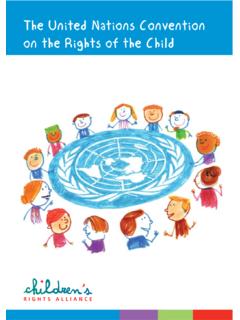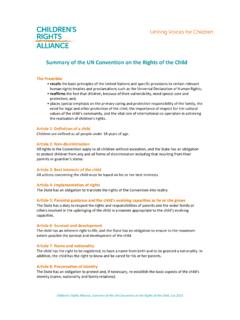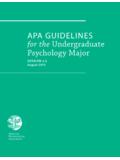Transcription of Part III 44 - Children's Rights
1 The UN Convention on the Rights of the Child United Nations, June 2010. Reproduced with is a booklet by the Children s Rights Alliance. ISBN 0-9553005-4-1978-0-9553005-4-7 The Children s Rights Alliance is a coalition of over 90 non-governmental organisations (NGOs)working to secure the Rights and needs of children in Ireland, by campaigning for the fullimplementation of the UN Convention on the Rights of the Child. It aims to improve the lives of allchildren under 18, through securing the necessary changes in Ireland s laws, policies and Children s Rights Allliance is jointly funded by the Atlantic Philanthropies, the Department ofCommunity, Equality and Gaeltacht Affairs and the One s Rights Alliance4 Upper Mount StreetDublin 2, IrelandTel: +353 1 662 9400 Email: Note: This booklet contains the Preamble and Articles 1-54 of the United Nations Convention onthe Rights of the Child.
2 The Preamble and Articles comprise Annex Iof the UN Convention text. Thetext of Annex IIand Annex IIIis not included in this booklet. Annex IIlists the states that have signedthe UN Convention as well as the date of the signature, ratification/accession and the date onwhich it entered into force for each state. Annex IIIprovides guidelines to states (also known as State Parties ) on the form and content of the State Report to the UN Committee on the Rights ofthe I7 Part II38 Part III44 This Children s Rights Alliance booklet reproduces the full text ofthe UN Convention on the Rights of the Child (1989), in both theIrish and English languages, for the children and young people ofIreland and for those charged with securing their Rights and needs. What is the UN Convention on the Rights of the Child?
3 The UN Convention on the Rights of the Child is a comprehensive, inter-nationally binding agreement on the Rights of children, which was adoptedby the United Nations General Assembly in 1989. It is the most widelyratified human Rights treaty in history: all countries have ratified it with theexception of the United States of america and Somalia. When countries ratify an international treaty or convention, such as theUN Convention on the Rights of the Child, they enter a binding agreementto meet its provisions and obligations. Ireland signed the UN Conventionon 30 September 1990, and ratified it on 28 September 1992. This meansthat the Irish State committed itself to promote, protect and fulfil therights of children, as outlined in the UN Convention. A child is defined in the UN Convention as a person under the age of 18years.
4 The UN Convention acknowledges the family as the fundamentalunit of society. It stresses the role of parents as the primary care-givers withresponsibility for the up-bringing of their children and obligesgovernments to support parents in fulfilling their essential Principles of the UN ConventionThe UN Convention on the Rights of the Child has adopted an integratedand holistic approach to the Rights of children. In other human rightsinstruments, economic, social and cultural Rights have been dealt withseparately from civil and political Rights , but in the UN Convention they areall brought together in an innovative way. The Rights are all seen asnecessary for the full and harmonious development of the child spersonality and inherent to the dignity of the child. The different Rights arenot ranked in order of importance; instead they interact with one anotherto form dynamic parts of an integrated unit.
5 That said, special emphasis isgiven to four articles, known as general principles , because they areconsidered basic to the implementation of all of the other Rights containedwithin the UN Convention. The four general principles are: that all the Rights guaranteed by the Convention must be available to allchildren without discrimination of any kind (Article 2); that the best interests of the child must be a primary consideration in allactions concerning children (Article 3); that every child has the right to life, survival and development (Article 6); and that the child s views must be considered and taken into account in all matters affecting him or her (Article 12).2 Ireland and the UN ConventionTo promote the implementation of the UN Convention, the UN Committeeon the Rights of the Child conducts a review and monitoring process everyfive years with each ratifying country.
6 To date, the Committee hasexamined Ireland s performance on two occasions, in 1998 and each examination, the UN Committee issues a set of commentsand recommendations (known as Concluding Observations ) whichprovide a roadmap to the State on the actions it needs to take to makechildren s Rights a reality. Since ratification of the UN Convention on the Rights of the Child in 1992,Ireland has made some significant progress in realising the Rights andmeeting the needs of children. Advances include the publication of theNational Children s Strategy (2000); the establishment of the NationalChildren s Advisory Council (2001); the appointment of Ireland s firstOmbudsman for Children (2004); and the development and strengtheningof child participation and consultation mechanisms, including D il na n g(youth parliament) and Comhairle na n g (local youth councils); andlegislative reforms of the youth justice system, through the Children Act2001.
7 Central to this progress was the establishment of the National Children sOffice in 2001. This office was augmented in 2005 and its remit furtherexpanded in 2008 to form the Office of the Minister for Children andYouth Affairs. The Minister for Children and Youth Affairs (who attends allCabinet meetings) has responsibility for overseeing implementation of theNational Children s Strategy and coordinating Government policy , the realisation of children s Rights is an uphill battle. In manyinstances, we continue to use a welfare-based approach to children s issuesrather than a Rights -based approach, as necessitated by the UNConvention. We develop good policies for children s services and supports,but continue to fail to deliver on these commitments, particularly in thearea of child protection and care.
8 Furthermore, the full implementation of the UN Convention in Ireland isthwarted by the fact that the UN Convention s principles and provisionshave not yet been brought into our domestic law. Children s Rights arealmost invisible within our Constitution. In February 2010, the JointCommittee on the Constitutional Amendment on Children reached allparty consensus on proposed wording for an amendment to theConstitution to strengthen children s Rights . All political parties havecommitted to the holding of a referendum. The successful passage of areferendum on children s Rights is a vital next step to ensure, among otherthings, that the best interests of the child is a primary consideration in allactions concerning children. Ireland still has a long way to go on its journey to make Ireland one of thebest places in the world to be a child.
9 We hope you will work with us tomake the vision of childhood, outlined in the pages of the UN Conventionand this booklet, a reality. To learn more, go to: States Parties to the present Convention,Considering that, in accordance with the principles proclaimed in the Charterof the United Nations, recognition of the inherent dignity and of the equal andinalienable Rights of all members of the human family is the foundation offreedom, justice and peace in the world,Bearing in mind that the peoples of the United Nations have, in the Charter,reaffirmed their faith in fundamental human Rights and in the dignity and worthof the human person, and have determined to promote social progress andbetter standards of life in larger freedom,Recognizing that the United Nations has, in the Universal Declaration of HumanRights and in the International Covenants on Human Rights .
10 Proclaimed andagreed that everyone is entitled to all the Rights and freedoms set forth therein,without distinction of any kind, such as race, colour, sex, language, religion,political or other opinion, national or social origin, property, birth or otherstatus,Recalling that, in the Universal Declaration of Human Rights , the United Nationshas proclaimed that childhood is entitled to special care and assistance,Convinced that the family, as the fundamental group of society and the naturalenvironment for the growth and well-being of all its members and particularlychildren, should be afforded the necessary protection and assistance so that itcan fully assume its responsibilities within the community,Recognizing that the child, for the full and harmonious development of his orher personality, should grow up in a family environment, in an atmosphere ofhappiness, love and understanding,5 Considering that the child should be fully prepared to live an individual life insociety, and brought up in the spirit of the ideals proclaimed in the Charter ofthe United Nations, and in particular in the spirit of peace, dignity, tolerance,freedom, equality and solidarity,Bearing in mind that the need to extend particular care to the child has beenstated in the Geneva Declaration of the Rights of the Child of 1924 and in theDeclaration of the Rights of the Child adopted by the General Assembly on 20 November 1959 and recognized in the Universal Declaration of Human Rights ,in the International Covenant on Civil and Political Rights (in particular in articles23 and 24)







